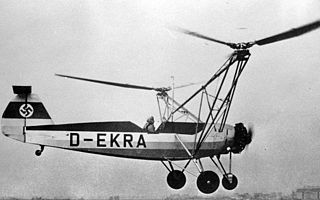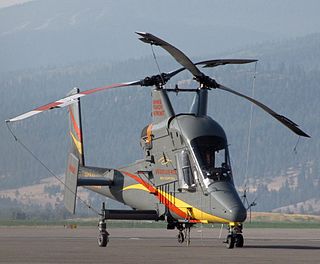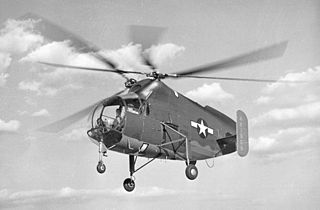Related Research Articles

An autogyro, or gyroplane, is a class of rotorcraft that uses an unpowered rotor in free autorotation to develop lift. Part 1 of Subchapter A of Chapter I of Title 14 of the U. S. Code of Federal Regulations states that gyroplane "means a rotorcraft whose rotors are not engine-driven, except for initial starting, but are made to rotate by action of the air when the rotorcraft is moving; and whose means of propulsion, consisting usually of conventional propellers, is independent of the rotor system." While similar to a helicopter rotor in appearance, the autogyro's unpowered rotor disc must have air flowing upward across it to make it rotate.

Juan de la Cierva y Codorníu, 1st Count of la Cierva, was a Spanish civil engineer, pilot and a self-taught aeronautical engineer. His most famous accomplishment was the invention in 1920 of a rotorcraft called Autogiro, a single-rotor type of aircraft that came to be called autogyro in the English language. In 1923, after four years of experimentation, De la Cierva developed the articulated rotor, which resulted in the world's first successful flight of a stable rotary-wing aircraft, with his C.4 prototype.

The Focke-Wulf Fw 61 was the first successful, practical, and fully controllable helicopter, first flown in 1936. It was also known as the Fa 61, as Focke began a new company—Focke-Achgelis—in 1937.

The Focke-Achgelis Fa 223 Drache was a helicopter developed by Germany during World War II. A single 750-kilowatt (1,010 hp) Bramo 323 radial engine powered two three-bladed 11.9-metre (39 ft) rotors mounted on twin booms on either side of the 12.2-metre-long (40 ft) cylindrical fuselage. Although the Fa 223 is noted for being the first helicopter to attain production status, production of the helicopter was hampered by Allied bombing of the factory, and only 20 were built.

The Sikorsky R-4 is a two-seat helicopter that was designed by Igor Sikorsky with a single, three-bladed main rotor and powered by a radial engine. The R-4 was the world's first large-scale mass-produced helicopter and the first helicopter used by the United States Army Air Forces, the United States Navy, the United States Coast Guard and the United Kingdom's Royal Air Force and Royal Navy. In U.S. Navy and U.S. Coast Guard service, the helicopter was known as the Sikorsky HNS-1. In British service it was known as the Hoverfly.

The Flettner Fl 282 Kolibri (Hummingbird) is a single-seat intermeshing rotor helicopter, or synchropter, produced by Anton Flettner of Germany. According to Yves Le Bec, the Flettner Fl 282 was the world's first series production helicopter.

The Cierva C.30 is an autogyro designed by Juan de la Cierva and built under licence from the Cierva Autogiro Company by A V Roe & Co Ltd (Avro), Lioré-et-Olivier and Focke-Wulf.

A rotary-wing aircraft, rotorwing aircraft or rotorcraft is a heavier-than-air aircraft with rotary wings that spin around a vertical mast to generate lift. Part 1 of Subchapter A of Chapter I of Title 14 of the U. S. Code of Federal Regulations states that rotorcraft "means a heavier-than-air aircraft that depends principally for its support in flight on the lift generated by one or more rotors." The assembly of several rotor blades mounted on a single mast is referred to as a rotor. The International Civil Aviation Organization (ICAO) defines a rotorcraft as "supported in flight by the reactions of the air on one or more rotors".

An intermeshing-rotor helicopter is a helicopter with a set of two main rotors turning in opposite directions, with each rotor mast mounted with a slight angle to the other, in a transversely symmetrical manner, so that the blades intermesh without colliding. The arrangement allows the helicopter to function without a tail rotor, which saves power. However, neither rotor lifts directly vertically, which reduces efficiency per each rotor.

A helicopter is a type of rotorcraft in which lift and thrust are supplied by horizontally spinning rotors. This allows the helicopter to take off and land vertically, to hover, and to fly forward, backward and laterally. These attributes allow helicopters to be used in congested or isolated areas where fixed-wing aircraft and many forms of short take-off and landing (STOL) or short take-off and vertical landing (STOVL) aircraft cannot perform without a runway.
The Cierva Autogiro Company was a British firm established in 1926 to develop the autogyro. The company was set up to further the designs of Juan de la Cierva, a Spanish engineer and pilot, with the financial backing of James George Weir, a Scottish industrialist and aviator.

The Kellett KD-1 is a 1930s American autogyro built by the Kellett Autogiro Company. It had the distinction of being the first practical rotary-wing aircraft used by the United States Army and inaugurated the first scheduled air-mail service using a rotary-wing aircraft.

Raoul Hafner, (1905–1980) FEng, FRAes, was an Austrian-born British helicopter pioneer and engineer. He made a distinctive contribution to the British aerospace industry, particularly in the development of helicopters.

A rotor kite or gyrokite is an unpowered, rotary-wing aircraft. Like an autogyro or helicopter, it relies on lift created by one or more sets of rotors in order to fly. Unlike a helicopter, gyrokites and rotor kites do not have an engine powering their rotors, but while an autogyro has an engine providing forward thrust that keeps the rotor turning, a rotor kite has no engine at all, and relies on either being carried aloft and dropped from another aircraft, or by being towed into the air behind a car or boat or by use of ambient winds for the kiting. As of 2009, no country in the world requires a license to pilot such a craft.

The Kellett XR-8 was a helicopter built in the United States during World War II. It was a two-seat machine intended to demonstrate the feasibility of a twin-rotor system and, while it accomplished this, it also demonstrated a number of problems that prevented further development of this particular design.
The Airborne Forces Experimental Establishment (AFEE) was a branch of the British Air Ministry, that researched and developed non-traditional airborne applications, such as gliders, rotary wing aircraft, and dropping of personnel and equipment by parachute, in the period 1942–1950.
References
- ↑ Goebel, Greg. "European Helicopter Pioneers." vectorsite.net. Retrieved: 10 October 2015.[ unreliable source? ]
- S Coates. Helicopters of the Third Reich 2003 Classic Publications ISBN 9781903223246
- Ryszard Witkowski, 2009 Allied Rotorcraft of the WW2 Period MMP Books
- Ryszard Witkowski, 2007 Rotorcraft of the Third Reich MMP Books
